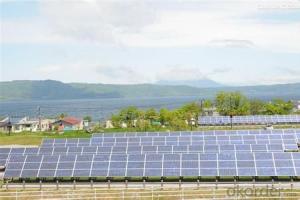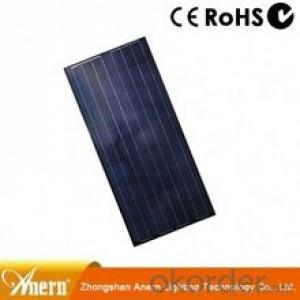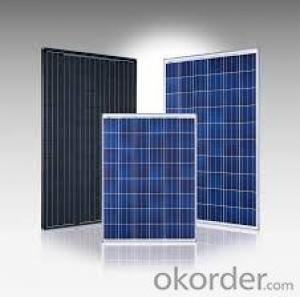Monocrystalline Silicon Home solar cells 50w
- Loading Port:
- China Main Port
- Payment Terms:
- TT OR LC
- Min Order Qty:
- -
- Supply Capability:
- -
OKorder Service Pledge
Quality Product, Order Online Tracking, Timely Delivery
OKorder Financial Service
Credit Rating, Credit Services, Credit Purchasing
You Might Also Like
Quick Details
| Model Number: | |||||
| Material: | Size: | Number of Cells: | |||
| Max. Power: | Certificate: | Color: | |||
| Frame: |
Packaging & Delivery
| Packaging Detail: | packaging:carton and wooden pallets. weight:4.3kg 20GP:2065pcs 40HQ:4310pcs |
| Delivery Detail: | 15-20 days ,depend on your order quantity. |
Specifications
1.17% conversion efficiency.
2.Excellent quality with good price.
3.100% TEST before and after encapsulation.
4.MOQ:100pcs
Design features of solar panel:
Front | Tempered glass |
Encapsulation | EVA |
Back | TPT |
Frame | Aluminum |
Warranty | 5 years |
Life time | 25 years |
Certificate | CE, ISO, ROHS |
Electrical characteristics:
| Maximum Power[Pmax] | 50W ±5% |
| Maximum Power Voltage[Vmp] | 18V ±3% |
| Maximum Power Current[Imp] | 2.77A ±3% |
| Short-Circuit Current[Isc] | 3.05A ±3% |
| Open-Circuit Voltage[Voc] | 21.6V ±3% |
| Current Temperature coefficient | 0.08%/ ℃ |
| Voltage Temperature Coefficient | -0.32%/ ℃ |
| Power Temperature Coefficient | -0.38%/ ℃ |
| Maximum System Voltage | 1000V |
- Q:Can solar cells be used for powering remote medical clinics?
- Yes, solar cells can be used for powering remote medical clinics. Solar energy is a reliable and sustainable source of power that can be harnessed in remote areas where access to electricity is limited. By installing solar panels, medical clinics can generate electricity to power essential medical equipment, lighting, and other necessary devices, ensuring continuous operations and better healthcare services even in remote locations.
- Q:What is the accurate explanation for the sun solar cell power system? How does it work?
- The sun solar cell power system is actually working better than the other ways, because the quality guarantee period of crystalline silicon solar cells is 15 years, and the service life is more than 25 years.
- Q:Can solar cells be used for powering water pumps?
- Yes, solar cells can be used for powering water pumps. Solar-powered water pumps utilize the energy from the sun captured by solar cells to generate electricity, which then powers the water pump. This sustainable and environmentally-friendly solution is often used in remote areas where there is no access to electricity grids or where using traditional fuel-powered pumps is costly or impractical.
- Q:Can solar cells be used to power agricultural irrigation systems?
- Yes, solar cells can be used to power agricultural irrigation systems. Solar cells can convert sunlight into electricity, which can then be used to power pumps and other components of irrigation systems. This offers a sustainable and cost-effective solution for powering irrigation systems in remote areas or locations without access to grid electricity.
- Q:How do solar cells perform in areas with high levels of pollen?
- Solar cells can be affected by high levels of pollen in certain ways. Pollen, when accumulated on the surface of solar panels, can reduce their efficiency by blocking sunlight from reaching the cells. This reduction in efficiency can result in a decrease in the overall energy generation of the solar panels. Hence, it is important to regularly clean and maintain solar panels in areas with high pollen levels to ensure optimal performance.
- Q:What is the impact of solar cells on reducing energy poverty?
- Solar cells have a significant impact on reducing energy poverty by providing access to electricity in remote areas that are not connected to the grid. They offer a reliable and sustainable source of power, enabling households to meet their basic energy needs and improve their quality of life. Additionally, solar cells reduce dependence on expensive and polluting fossil fuels, making energy more affordable and environmentally friendly for those living in poverty.
- Q:Can solar cells be used in water purification systems?
- Yes, solar cells can be used in water purification systems. Solar-powered water purification systems utilize solar energy to power the required processes, such as filtration, disinfection, and desalination. Solar cells can generate electricity from sunlight, which can be used to power pumps, UV lamps, or other components of the water purification system. This sustainable and environmentally friendly approach is particularly useful in areas with limited access to electricity or in off-grid locations.
- Q:How are solar cells installed?
- Solar cells are typically installed on rooftops or open ground areas. First, the installation site is surveyed to determine the best location and angle for maximum sunlight exposure. Then, the solar panels are mounted onto a structure using brackets or frames. The panels are interconnected and wired to an inverter, which converts the direct current (DC) generated by the panels into usable alternating current (AC) electricity. Finally, the system is connected to the electrical grid or a battery storage system, allowing the generated solar energy to be used for powering homes or businesses.
- Q:Can solar cells be used in mobile devices?
- Yes, solar cells can be used in mobile devices. In fact, many modern smartphones and tablets are equipped with solar panels or have the capability to be charged using solar energy. This allows for increased energy efficiency and convenience, especially when used in outdoor or remote locations.
- Q:How do solar cells perform in areas with high levels of bird droppings?
- Solar cells may experience a decrease in performance in areas with high levels of bird droppings. The droppings can create a layer of dirt and debris on the surface of the solar cells, reducing their efficiency in converting sunlight into electricity. Regular cleaning and maintenance are necessary to ensure optimal performance in such areas.
1. Manufacturer Overview |
|
|---|---|
| Location | |
| Year Established | |
| Annual Output Value | |
| Main Markets | |
| Company Certifications | |
2. Manufacturer Certificates |
|
|---|---|
| a) Certification Name | |
| Range | |
| Reference | |
| Validity Period | |
3. Manufacturer Capability |
|
|---|---|
| a)Trade Capacity | |
| Nearest Port | |
| Export Percentage | |
| No.of Employees in Trade Department | |
| Language Spoken: | |
| b)Factory Information | |
| Factory Size: | |
| No. of Production Lines | |
| Contract Manufacturing | |
| Product Price Range | |
Send your message to us
Monocrystalline Silicon Home solar cells 50w
- Loading Port:
- China Main Port
- Payment Terms:
- TT OR LC
- Min Order Qty:
- -
- Supply Capability:
- -
OKorder Service Pledge
Quality Product, Order Online Tracking, Timely Delivery
OKorder Financial Service
Credit Rating, Credit Services, Credit Purchasing
Similar products
New products
Hot products
Hot Searches
Related keywords

























